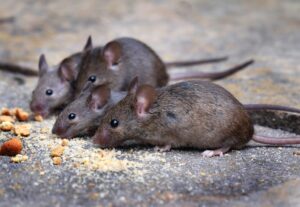When it comes to pest control for commercial properties, rodents are often the main concern of warehouses and storage facilities. Being a more intelligent, cunning and often dangerous threat than other pests, rats and mice are the nightmare of many business owners in Alberta, Saskatchewan, Manitoba, and Western Canada. But why do rodents target large industrial areas and what can be done to keep your commercial building free from these unwanted visitors? Let’s delve into it.
Why Are Rats and Mice Attracted to Warehouses and Storage Facilities?
Rats and mice need food and shelter. During the coldest months of the year, rodents have more difficulties finding the resources they need outside. Commercial properties, especially warehouses and storage facilities managing food related products will offer everything rodents are looking for: something to eat and a warm and comfortable environment in which to breed. For these reasons, business owners must be extra careful when keeping mice and rats away from their properties.
Signs That You May Be Dealing with a Mouse or Rat Infestation
In most cases, by the time you see the first rat or mouse in your warehouse, you are probably dealing with more rodents hidden in other areas. While rodents are excellent at hiding, there are common signs that can tell you that rats or mice have found their way into your commercial building. Common signs of rodents include:
Droppings and urine are often the first signs of rodents and are found in areas where rodents travel or spend time. Rat droppings are usually between 1.25 and 2 centimetres (½ to ¾ inches) in length. Mouse droppings are generally less than one centimetre in length or around the same size as a grain of rice. Over time, grease marks from rodent bodies can be left on surfaces they contact.
Finding food in unusual places and pieces of shredded paper, insulation fragments, fabrics, and other materials collecting in out-of-the-way areas may be a sign that rodents are hoarding food and building their nests somewhere in your storage facility.
Rodent urine and feces release a distinctive and unpleasant smell. If you have recently noticed unusual musky or fishy odours in your commercial property, you may be dealing with a rodent infestation.
If chew marks on food and holes gnawed into products or the structure itself are not common in your operations, these signs may indicate the presence of mice and rats.
Rat and Mouse Prevention and Control Strategies for Large Spaces
Rat and mouse control for commercial property generally means tackling entry points, preventing access to food, and using appropriate tools to control rodents. Here are useful strategies you can try:
Young mice can squeeze their bodies through spaces of 0.64 centimetres (¼ of an inch), meaning a gap smaller than the width of a pencil will give enough space for them to crawl into your warehouse. Properly spotting and sealing every entry point in your commercial property is a fundamental step to keeping rats and mice away. Both rats and mice are excellent climbers and jumpers making it important to seal holes at any height, not just at ground level.
Another efficient mouse and rat prevention strategy is by installing advanced monitoring systems and traps in your commercial property. This generally includes motion cameras that can identify movement in areas that rodents may use to gain entry, as well as traps and products and prompt action taken, which is fundamental for pest control.
Rats and Mice are attracted to food. This means that keeping your facilities clean and organized, and food sources secured from rodents is essential when trying to keep rodents from overtaking your warehouse. Make sure trash is properly contained and removed. It is also recommended to have a dedicated room for employees to eat, to prevent food from being accessible to rodents in multiple areas. An organized facility makes it easier and faster for regular inspections to detect the presence of mice and rats.
Another way of making your storage facility less attractive for rats and mice is by reducing their food and shelter options outdoors. This is because rodents will typically come from nearby areas, although sometimes they can be brought in with deliveries. Keep grass and plants well-trimmed to prevent hiding spots. Keep garbage in tough bins with well-sealed lids.
When to Ask for Professional Help
Dealing with a mouse or rat infestation can be a difficult challenge for warehouse and storage facility owners who already have many concerns involving the operations of their business. For that reason, it is always recommended that you rely on specialists if you have spotted the presence of rodents in your commercial facility. Even though getting rid of a single mouse may not seem like a difficult task, it is often hard to tell you are 100% free of rodents without the help of a professional. Experienced pest management professionals will be able to help you get rid of any pests in a more efficient way.
Your Choice for Pest Control in Alberta, Saskatchewan, Manitoba, and Western Canada
Having issues with rodents in your commercial property? Looking for professionals who can help you get rid of rats and mice in your warehouse? Poulin’s Pest Control is here for you. With experienced professionals and a wide variety of efficient products, we have the necessary expertise and equipment to keep your commercial property free of any unwanted visitor. Don’t hesitate to give us a call and let us provide you with efficient and reliable pest control services in Manitoba, Saskatchewan, and Alberta. Reach out to us!

